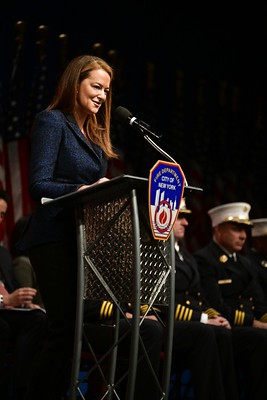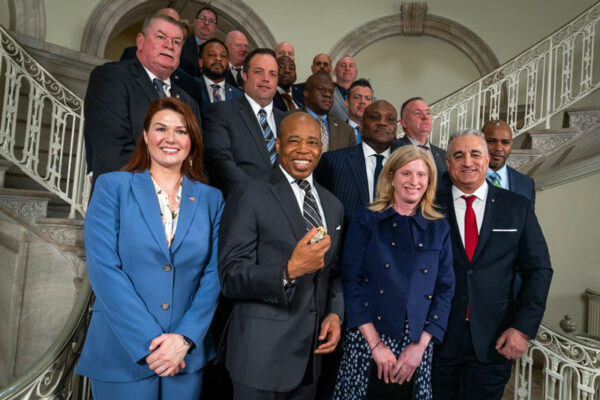New York, NY – The city’s two-year battle with COVID that has killed 40,500 residents — 10,000 more than perished during the Spanish Flu outbreak a century ago — has only reinforced just how essential the FDNY’s Emergency Medical Service is in a place where so many people lack regular access to healthcare, according to Acting Fire Commissioner Laura Kavanagh.

At the height of the first COVID wave on March 30, 2020, the FDNY’s EMS was swamped with over 6,000 emergency calls. With all of the city’s hospitals overwhelmed, FDNY EMS responded to an exponential spike in cardiac arrests at home with almost 300 on a single day, over ten times the rate seen pre-pandemic.
“I think what I have seen in the public and certainly saw during the pandemic when we go visit EMS stations there’s much greater recognition of EMS,” Kavanagh said during an interview six months into her tenure as acting commissioner. “I think that often that EMS has felt it was in the background and even by the public, they didn’t see EMS as much unless they called. Even EMS stations are often in areas out of the way of public view.”
Kavanagh continued. “And what I saw during the pandemic when I was visiting the EMS stations I would see ‘thank you’ signs — lunch—dinner [brought by the community]. I see that following that, there’s a much greater recognition of what EMS does especially in New York at the height of the pandemic when EMS was the only resource that a lot of people had for medical care with the hospitals overflowing and everything else that was going on.”
WAS IT THE RIGHT MOVE?
Historically, the decision by then Mayor Giuliani to shift the city’s EMS out from under the jurisdiction of the city’s Health + Hospitals municipal hospital system to the FDNY produced a ‘plantation’ like situation where Emergency Medical Technicians [EMTs], largely female and people of color, had to work alongside white firefighters who made tens of thousands of dollar more than them.
That inequity extends to healthcare benefits with firefighters enjoying unlimited sick time while EMS has less than two weeks.
While DC 37 Local 2507, which represents 4,000 FDNY EMTs, Paramedics and Fire Inspectors and DC Local 3621, which represents FDNY EMS officers made salary gains in their last contract, the pay and benefit gap between EMS and fire operations persists. As a consequence, a significant number of FDNY EMTs opt to leave EMS to take what the FDNY terms “a promotion” to firefighter.
As a consequence, this persistent churn of FDNY EMTs to fire operations results in a relatively inexperienced EMS workforce subject to high turnover and low morale at a time when the city’s entire healthcare system as a whole has been under unprecedented stress culminating most recently in the unprecedented COVID pandemic.
Over the last 20 years, New York State has closed 41 hospitals with 18 of them located in New York City. Kavanagh says that massive contraction puts much greater strain on FDNY EMS members.
THE BIG SQUEEZE PLAY
“There’s been a lot written about the closure of hospitals and I think it’s something we see in EMS when hospitals close there are fewer places for EMS to go,” Kavanagh said. “We have to go further and wait longer and so that means the turnaround time for an individual crew is that much longer. So, this has been an issue talked about at the local community level but is an issue writ large for the entire health care system.”
During the pandemic, New York City’s Health + Hospitals’ Elmhurst Hospital was so overwhelmed it had to resort to refrigeration trucks to accommodate its COVID dead and became an international symbol for a healthcare system in meltdown.
In a July 2021 interview, FDNY EMS Captain John Burke, who covers the part of Queens where Elmhurst is located, said “right around the corner in that neighborhood alone we lost Mary Immaculate Hospital and St. Joseph’s Hospital.” In addition, he said, the borough also lost St. John’s Hospital and Parkway Hospital.
“The loss of hospital beds and loss of those emergency rooms is a real stressor for us, because you are traveling a greater distance to get a patient to the ER, which leaves your coverage area exposed with fewer ambulances. And then there’s the travel time back for the units,” he said. “It’s a real issue out on the Rockaways, where they lost Peninsula Hospital and now there is only one hospital serving that entire area.”
EMS UNIONS KNEW FIRST
At the height of the initial wave of the pandemic, when New York State and New York City were focused entirely on fighting COVID in the hospitals, the FDNY EMS unions urged public health officials to take the fight into the homes and neighborhoods they were attending to, a strategy that eventually got traction in the vaccination phase of the fight.
“It would be helpful to take this fight out into the community to improve the health conditions of people who are now fearful of the hospital and staying out of those systems and dying at home,” Oren Barzilay, president of Local 2507, said at the time. “This disease is particularly pronounced in the poorer neighborhoods. You just won’t contain it if you don’t address it where people live in such crowded conditions and they have nowhere else to go.”
“We do need to find a way to reach out to people hidden in our communities who may not feel comfortable seeking medical attention or going to the hospital for fear of getting a bill,” said Vincent Variale, president of DC 37 Local 3621, which represents EMS officers. “If you don’t have universal testing for everybody, we will never get back to the society we remember.”
Kavanagh said that more than two years into the pandemic, the essential role the FDNY EMS can play in improving community health care was “better understood but not fully understood yet.”
COVID’S VICE
The unprecedented stress and strain on the FDNY EMS has had real world consequences for its members and their families who remain at an elevated risk to COVID infection. Union officials have reported dozens of instances where members are suffering with disabling long haul COVID.
At least eleven FDNY EMTs and officers died from COVID. Four committed suicide. Close to a third of the 4,500 FDNY EMS and EMS Officers on the job were out sick with the virus at the peak of the waves of the pandemic. “I think you could say easily that all totaled, three quarters of us have had it,” Variale said.
A recent LaborPress investigation revealed the alarming statistics showing a dramatic spike in violent assaults on the FDNY EMS workforce are only a partial picture of challenging workplace conditions faced by the entire sector that includes volunteer and private sector EMS also serving throughout the city alongside their civil service colleagues.
International and national occupational health reports have flagged a troubling uptick in violent assaults on EMS workers as COVID paced unprecedented stress on public health systems here and around the world.
The FDNY EMS workforce, rank and file as well as officers, is close to 5,000. According to the EMSPAC, a non-profit advocacy group, NYC’s has a total of 14,500 EMS workers divided into four “distinct deployment models with different funding channels, varying benefits, uniform colors, vehicle colors, conditions, and levels of prestige–FDNY 911 Municipal, Voluntary Hospital 911, Private Inter-facility Transport, and Community Volunteers.”
In that mix include private sector EMS providers that are non-union. There is no integrated database tracking assaults on public, private sector and community based volunteer EMS members. The FDNY statistics tracks only assaults on FDNY employees who are civil servants covered under New York State’s Public Employee Safety & Health Bureau that was created in 1980.
In 2018, according to the FDNY, there were 163 assaults on FDNY EMS workers. In 2019, that jumped to 217. In 2020, the start of the pandemic, it hit 329, spiking to 386 last year.
Over the same arc of time, the number of patients that assaulted their FDNY EMS caregiver went from 107 to 237 last year. By contrast, violent attacks by a member of the public, not the patient, like a family member, went from 22 in 2018 to 126 in 2021.
Not captured in this FDNY tracking are incidents like the recent shooting of EMT Richard McMahon, 25, who works for Staten Island’s Richmond University Medical Center, which provides EMS coverage for the city’s 911 system. McMahon is a member of 1199 SEIU.
Mike Greco, vice-president of DC 37’s Local 2507, which represents the FDNY’s EMTs, Paramedics and Fire Inspectors, said in a phone interview that McMahon’s encounter underscores just how perilous a situation EMTs can find themselves in. “We can’t even frisk somebody for weapons — it would be illegal — we are not peace officers,” Greco said.
Variale thinks the city should be tracking assaults on any emergency medical service personnel answering FDNY 911 calls, including the private sector services where workers may or may not be represented by a union to support them.
Kavanagh agrees.
“Yes. I think, as you know, we have worked over the years to get greater data sharing with the hospitals systems and our private partners in EMS in the hospitals and volunteers and that’s something we’d like to have access too.,” she said.
A NEW CALCULUS?
For decades, police and fire unions have argued that their professors were the most hazardous of the uniformed emergency services. Yet there are signs that the ongoing pandemic and troubling trends in workplace assaults on EMS are new variables.
As LaborPress previously reported, a pre-pandemic survey of close to 2,000 EMTs from 13 countries, mostly from the United States, found that two-thirds reported having been assaulted on the job with weapons being used in 10-percent of the incidents.
“These EMS personnel have a rate of occupational fatality comparable to firefighters and police, and a rate of nonfatal injuries that is higher than the rates for police and firefighters and much higher than the national average for all workers,” the researchers reported in their study that was published by Cambridge University Press. “Emergency Medical Services personnel in the US have a rate of occupational violence injuries that is about 22-times higher than the average for all workers.”






